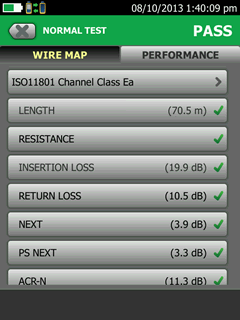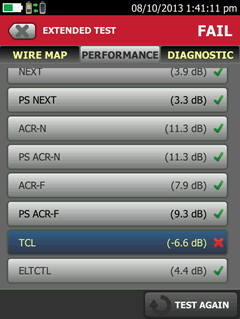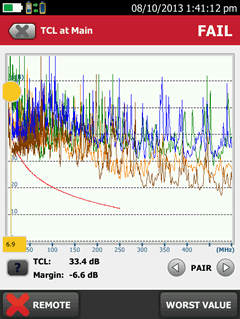TCL & ELTCTL - optional or required
The standards are clear, balance parameters are required to establish conformance:
- ISO/IEC 11801 Edition 2.2 2011-06 has TCL and ELTCTL requirements for the Channel, but not the Permanent Link.
- ANSI/TIA-568-C.2 has TCL and ELTCTL requirements for the Channel, but not the Permanent Link.
- Both standards make reference to TCL and TCTL (or ELCTCL) requirements for connectors and cable.
However the message is not as clear as to whether it is mandated to test these parameters in the field:
- ISO/IEC 11801 Edition 2.2 2011-06 Table B.1 shows TCL and ELTCTL to be an informative test for "Installation conformance testing".
- ANSI/TIA-TIA 1152 (the standards for TIA field testing) does not mandate installation testing of TCL and ELTCTL.
TCL and ELTCTL are required to be conformant and must be tested in the laboratory or when certification is sought from an independent test house. They are not required to be tested in the field. This can create the potential for non-conforming product or poor installation techniques to be missed.
These balance measurements are recognized to be important, but not typically performed in the field for two reasons:
- Only recently have field testers been capable of making TCL and ELTCTL measurements.
- A lack of publicity on how these parameters could complement the troubleshooting tests that are typically performed when issues with applications are identified.
In the example below, the user tested the link to ISO/IEC 11801 Edition 2.2 2011-06 Class EA (Similar to Cat 6A). It passed with good margins.

However, the Gigabit Switch kept backing down from 1000 Mbps to 100 Mbps; note this was a compliant 500 MHz cabling system.
As part of a troubleshooting exercise, the user tested this link for TCL and compared the results to the normative requirements of ISO/IEC 11801Edition 2.2 2011-06 for a Class EA Channel using a DSX-5000 CableAnalyzer.


The link failed to meet the TCL performance requirements for an ISO/IEC 11801 Edition 2.2 2011-06 Class EA Channel with a negative margin of -6.6 dB. Given 6 dB represents a factor of two, we can say this link exhibited more than double the permitted TCL.
The user replaced the connectors in the hope they were the cause. Sadly, the TCL was still poor and more importantly, the 1000 Mbps switch still kept backing down to 100 Mbps. This indicated a cable issue, so a new cable was sourced and terminated with the original connectors. The TCL test was conducted again resulting in a PASS and a significant improvement in TCL margin. And this time, the switch operated at 1000 Mbps and did not back down to 100 Mbps.
In the absence of a mandatory field test for these conformance parameters, it is left to the decision of the installer/customer as to whether the installation will be assessed for TCL and ELTCTL compliance. Certainly in the situation where an otherwise conformant channel is exhibiting application errors or other application issues, additional balance measurements are something you may wish to consider in order to investigate any otherwise hidden problems.
If you are concerned about additional test times, you can click here to see the different test times for the DSX CableAnalyzer.





